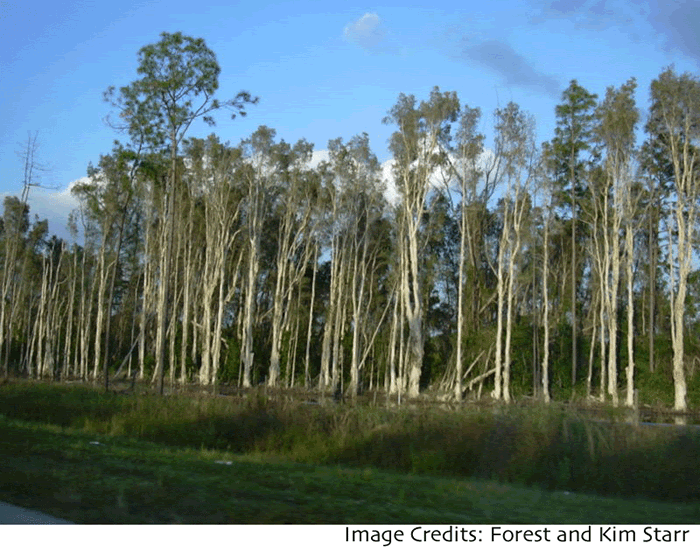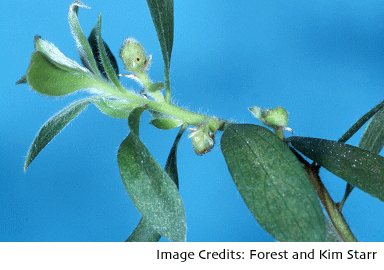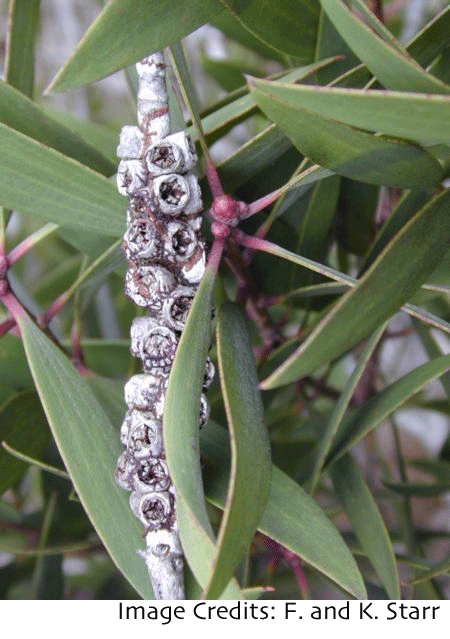2024 W. Main Street, Suite A200
Durham, NC 27705-4667
Tel: (919) 668-4551
Fax: (919) 668-9198
info@nescent.org
Identifying Biocontrol Agents Through Applied Systematics
The invasive Australian paperbark tree is wreaking havoc on the Florida Everglades. Introduced to Florida in the early 1900s, paperbark now covers more than a half million acres and if it continues at the present pace it is predicted to overtake southern Florida by 2024. The tree grows in dense stands and can grow up to 30 m. The trees flower prolifically and spread rapidly. A mature tree can carry 56 million seeds, although only about 840,000 will be viable. Ironically, the plant is considered threatened in its native Australia where a number of parasites combined with human encroachment have reduced its numbers significantly.
This invasion has large social and economic consequences. Healthwise, the massive amounts of pollen produced by the paperbark contribute to allergy problems. Ecologically, the tree is very damaging as dense stands push out native plants and form monocultures. This reduces access for outdoor activities such as hiking and boating, and also destroys natural habitats and reduces biodiversity. Current control efforts include physical removal of the trees, which is very expensive, or pesticide control, which can either destroy native plants simultaneously, or require multiple applications. 
One possibility for controlling paperbark is to introduce a natural predator or parasite. A number of insect and microbial pests reduce the growth of paperbark in Australia. However, this is a program that must be carefully researched and planned. There are many examples of biocontrol gone terribly wrong. The cane toad in Australia is a perfect example. Cane toads were introduced in Queensland to control beetles in the sugar cane crops. Although cane toads have voracious appetites, it turns out that they do not eat the beetle pests but they have eaten everything else they can find – including native toads and frogs, snakes, lizards, birds and eggs, and pet food. To add insult to injury, they themselves are extremely toxic and kill snakes, dogs, and other organisms that try to eat them. They have spread rapidly in Australia. Obviously, any potential biocontrol program needs to be carefully planned to avoid such devastating results.
M Among the proposed biocontrol programs for paperbark in Florida is a parasitic fly. In its native Australia, the bud-gall fly (Fergusonina) lays its eggs in flower and leaf buds of the paperbark. In the process of laying eggs, the fly also deposits nematodes which create a gall on the bud. The fly larvae feed on this gall as they mature and during the larval development the nematodes infect female fly ovaries. This is a very specific mutualistic relationship in which the flies transport nematodes to new sites, and the nematodes ensure a food supply (the gall) for the fly larvae. The fly-induced galls interfere with flower formation and general plant growth.
Among the proposed biocontrol programs for paperbark in Florida is a parasitic fly. In its native Australia, the bud-gall fly (Fergusonina) lays its eggs in flower and leaf buds of the paperbark. In the process of laying eggs, the fly also deposits nematodes which create a gall on the bud. The fly larvae feed on this gall as they mature and during the larval development the nematodes infect female fly ovaries. This is a very specific mutualistic relationship in which the flies transport nematodes to new sites, and the nematodes ensure a food supply (the gall) for the fly larvae. The fly-induced galls interfere with flower formation and general plant growth.
Prior to introducing a biocontrol agent, it must be known with certainty that the control agent is specific to the target, and that it is likely to remain so. These are questions that can be answered by systematics.
Tools
Case Study worksheet: Blunder from Down Under
The Biology Workbench provides a user friendly interface for students to use the same analysis tools as researchers. It also includes activities such as Studying How Different Organisms Are Related and Phylogeny 101.
This module from BioQUEST provides background information, tutorials, and activities using Baysian analysis - a common method used in building phylogenies. 
Fergusonina Phylogeny Demonstration
The file FergCOX1.fasta is a text file in fasta format that includes 13 mitochondrial Cytochrome Oxidase I sequences obtained by DNA extraction, PCR, and sequencing from various Fergusonina fly species. Researchers used these sequences to build the phylogeny in Scheffer, et al. First sequences are aligned, and then the alignment is used to generate a phylogenetic tree. This demonstration provides a streamlined version of the process.
1. Click on Jalview to launch the file from the Barton group. Three windows will open with colorful demos of different toolbox options. These windows may be closed.
2. To view the FergCOX1 file in Jalview, download and save the following file to your computer:
- For MACs: FergCOX1.fasta file by right clicking and "Save Link As". Under File at the top of the MAC desktop, not the Jalview window, select Input Alignment: From File and navigate to the FergCOX1.fasta file. If you cannot select the file it may be necessary to change the file formate, using the drop down menu on the bottom of the pop-up window, to "all files".
- For Windows: FergCOX1.fasta file by right clicking and "Save Target As". Under File on the Jalview2.3 screen, select Input Alignment: From File and navigate to the FergCOX1.fasta file If you cannot select the file it may be necessary to change the file formate, using the drop down menu on the bottom of the pop-up window, to "all files.
4.This should open into a nucleotide alignment window. In the Javaview window, one can choose Colour ...> Nucleotide... to get a nice view of the bases and their variability.
5. In the Jalview window choose Calculate>>Calculate Tree >>Neigbor Joining using % Identity---> The tree opens showing an estimate of phylogenetic relationships among the species. Notice that this is not the same tree as in Scheffer et al. Using different data and different tree building methods results in different trees. Analyzing these trees and determining which is most likely is an important task for systematists.
General Resources
Classroom Materials
The Evolution and the Nature of Science Institutes website has many classroom activities and articles useful for the topic of systematics and using phylogenies.
The De-riving Force of Cladogenesis
Cladistics is a Zip (for Grades 6-8)
Investigating Evolutionary Questions Using Online Molecular Databases
Phylogenetic Systematics, a.k.a. evolutionary trees
A step by step tutorial from Understanding Evolution.
The Great Clade Race: Presenting Cladistic Thinking to Biology Majors and General Science Students
by David Goldsmith
American Biology Teacher 2003 Vol 65(9):679-682
Available on BioOne
This class activity is a simple and effective introduction to how trees are built.
Video presentation by Dr. Brian Wiegmann (about 6 minutes).
Articles

Evolution Ch 27 Phylogenetic Reconstruction
Barton, N.H, Briggs, D.E.G., Eisen, J.A., Goldstein, D.B., Patel, N.H. CSHL Press. 2007. ISBN 978-087969684-9
This online chapter provides a detailed description of the steps and methods for building phylogenies.
Understanding Evolutionary Trees
by T. Ryan Gregory
Evolution: Education and Outreach 2008 Vol1(2):121-137 doi 10.1007/s12052-008-0035-x
This article outlines several common misconceptions in interpreting phylogenies.
This website includes many resources and articles on tree-thinking.
College Students' Misconceptions About Evolutionary Trees
Meir, E., Perry, J., Herron, J.C., Kingsolver, J. 2007. The American Biology Teacher Vol 69(7) Online Publication p71-76
Available from BioOne DOI: 10.1662/0002-7685(2007)69[71:CSMAET]2.0.CO;2
References
From Invasive Plants of the Eastern United States. This website provides extensive background information on the paperbark tree and various biocontrol methods.
Beating the Australian Bush for Melaleuca enemies
This article from the USDA describes the work being done in developing the Fergusonina biocontrol system.
Goolsby, J.A., Makinson, J., Purcell, M. 2000. Seasonal phenology of the gall-makng fly Fergusonina sp. (Diptera: Fergusoninidae) and its implications for biological control of Melaleuca quinquenervia. Australian Journal of Entomology Vol 39:336-343
Scheffer, S.J., Giblin-Davis, R.M., Taylor, G.S., Davies, K.A., Purcell, M., Lewis, M.L., Goolsby, J., Center, T.D. 2004. Phylogenetic Relationships, Species Limits, and Host Specificity of Gall-Forming Fergusonina Flies (Diptera: Fergusoninidae) Feeding on Melaleuca (Myrtaceae). Annals of the Entomological Society of America Vol 97(6):1216-1221.
Return to the NESCent Education and Outreach Home Page.

 This problem space was originally developed for the 2009 Presidential Awards for Excellence in Math and Science Teaching NSF Workshops by Brian Weigmann, Sonja Scheffer, and Kristin Jenkins.
This problem space was originally developed for the 2009 Presidential Awards for Excellence in Math and Science Teaching NSF Workshops by Brian Weigmann, Sonja Scheffer, and Kristin Jenkins.



 ENSI
ENSI